how to become a dj
Perhaps you were blown away by a particularly talented DJ in a club recently or maybe you saw someone playing in front of thousands on the mainstage at Ultra or Tomorrowland and you thought to yourself…I want some of that.
Every DJ treads their own path, and if you want to become one, you will have to make your own way too, but most people take the same basic route from bedroom DJ to pro. If you want to know how to do it, here's our comprehensive guide to how to become a DJ.
Step 1. Decide what kind of DJ you want to be and understand the job
Before you embark on your career as a DJ, it helps to know what kind of DJ you want to be – and also to have realistic expectations.
There are many types of DJ. For example, some people make their living as mobile DJs, taking bookings for weddings and other private functions.
They usually own all their own equipment, including speakers, lights, smoke machines, and so on, and they provide a service that includes traveling to the venue, setting up the equipment, playing music, and then taking everything down at the end. Is this what you want to do?
This is quite different from a club DJ who plays at various nightspots in their area – or for those higher up the ladder, in different venues around the world. These DJs usually don't need to carry anything more than a USB with their music, a pair of headphones, and maybe a laptop.
Finally, there are those at the very top of the tree, the ones who jet around the globe, headlining the world's biggest festivals and getting paid a fortune for doing it. When you reach this point, you know you've truly made it.
However, while most people dream of headlining major festivals, very few people reach anything like this level, so when you start out on your DJing career, you should have realistic expectations.
The chances are, unless you're lucky, you won't progress beyond the local level – although, with hard work and dedication, anything is possible, so go follow your dreams.
But don't get into it for the wrong reasons. Don't become a DJ because you think it's a glamourous job or because playing music sounds easy.
Making it as a DJ will take lots of time and effort, and if you're not willing to put in the hours or accept the rejection and setbacks along the way, this is probably not the right job for you.
Step 2. Find out if you like it – and if you're any good
Before you commit to a career as a DJ, you need to find out if you like it – and if you can do it. DJing is an art, and while anyone can learn the basics, that doesn't mean you'll be good at it.
Most people get into DJing as a hobby, and it's only after a certain amount of time they realize they can turn it into a proper job.
This means before you decide you want to try to pursue a career as a DJ, you should find out if you like DJing and if you have any talent.
For this reason, if you've never DJed before in your life, the best advice is to invest in some entry-level equipment first and have a go. Then, if you find you enjoy it and you want to try doing it professionally, you can consider upgrading your gear as necessary.
Now let's think about what equipment to buy.
Step 3. Buy your basic gear
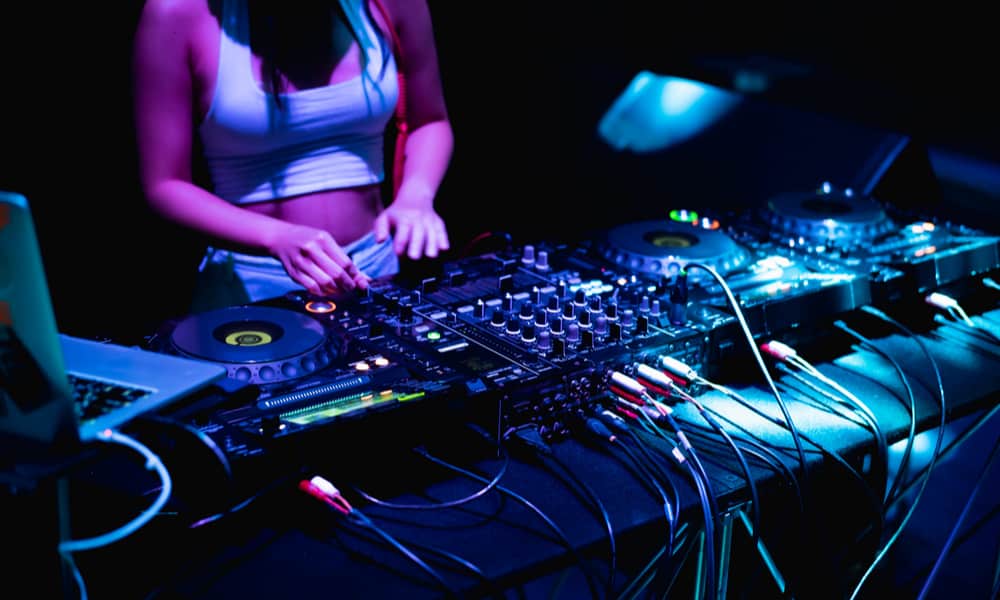
In the old days, DJing equipment consisted of a pair of turntables and a mixer, and for a long time, the club-standard you found just about anywhere DJs spun records was a pair of Technics 1210s.
Things have moved on a lot since then, and nowadays, people are DJ using wide range of setups.
If you're just starting out, you'll probably want to invest in something simple and affordable at the beginning – then you can upgrade if you decide you want to take it further.
Here are your basic options.
a). Laptop only
It's possible to DJ using just your laptop. All you need is DJing software, a pair of headphones, a speaker, and a special kind of splitter that can separate the headphone cue and the master output.
There are many types of DJ software to choose from, but if you're just looking have a go, Mixx is a good option. It's open-source and works with a range of DJ equipment – and best of all for the beginner is that it's completely free.
This means if you already own a laptop, a pair of headphones and a stereo or speaker to play the music through, you can probably start DJing for under $10.
For someone who just wants to try DJing, this is a great option because it costs next to nothing. It also has the advantage of being highly mobile, so if you get a gig somewhere that already has speakers, all you need to take is your laptop.
However, there are several downsides, too.
DJing is not easy or particularly fun on a laptop. You have no knobs or buttons to touch, so you control everything through the mouse and the keyboard, which is awkward.
Even if you start out like this, it's likely you will quickly want to progress to something more intuitive and tactile.
Then there's the way it looks.
While you might argue that DJing should just be about the music you play and not the equipment you use to create your sounds, there's no escaping the fact that some dude standing behind his computer doesn't exude the same kind of cool as a DJ on a full club setup.
Check out the DJ in this video to see what we mean.
So if you're looking for the cheapest way into the world of DJing, a laptop might be worth a go. Sometimes, you can see people DJing in bars just off a laptop, but if you want to take it further, for most people, it's not the best solution.
b). Turntables and a mixer
DJs who exclusively use vinyl nowadays are a rare breed, although some of the big-name DJs still like to have access to at least one turntable in their setup, even if it's just to show they can still beat-match the old-fashioned way.
Check out this video of Anna playing a vinyl-only set for Cercle.
However, for some DJing styles, vinyl is still the only way to go, and if you want to mix hip-hop, learn to scratch or enter DJ competitions, you should look at acquiring a pair of decks and a box of vinyl to play on them.
If that's the kind of DJing you're interested in, you'll need a pair of direct-drive turntables and a good battle DJ mixer. However, unless this is specifically what you want to do, turntables are probably not the best choice.
Vinyl is harder to track down, it costs more than digital music and it's heavy to carry to gigs. Digital, on the other hand, is cheaper, more practical, and it's easier to learn to use. In short, for most beginners, there are better options for your basic DJ setup than vinyl.
c). DJ players and a mixer
If you look at the gear in the DJ booth of just about any small club right up to what they're using on the main stage at Tomorrowland, you'll probably see the same thing.
The industry standard is a pair of (or three or even four) Pioneer CDJ-2000NXS2 DJ players.
When it comes to the mixer, there is a bit more variation. For example, some Allen & Heath mixers are popular, but the Pioneer DJM-900NXS2 is the most common – and the new Pioneer DJM-V10 also appears to be gaining some traction.
So DJ players and a mixer is the basic setup for most professional DJs around the world. But the main problem? The price.
This kind of set of setup is way out of reach of anyone just starting out – for four CDJs, a DJM-V10 – and throw in an RMX-1000 remix station that many DJs use now – and you are looking at the best part of $20,000.
You don't necessarily need to jump right in and buy the full club setup from the beginning, but even if you buy a pair of Pioneer's entry-level CDJs and their most inexpensive mixer, you're probably still looking at well over $1,000 for some very basic equipment.
Of course, Pioneer is not the only company that makes DJ equipment, and DJ players from Numark or Denon are also worth investigating.
In particular, Denon DJ's flagship SC5000 Prime player costs quite a bit less than the Pioneer equivalent, and many people would argue that it's a superior unit.
However, you're still looking at a very considerable investment, and my advice would be to see this kind of setup as something to aspire to when you become more established. For novice DJs, this kind of gear is too expensive – and not even necessary at the beginning.
d). DJ controllers
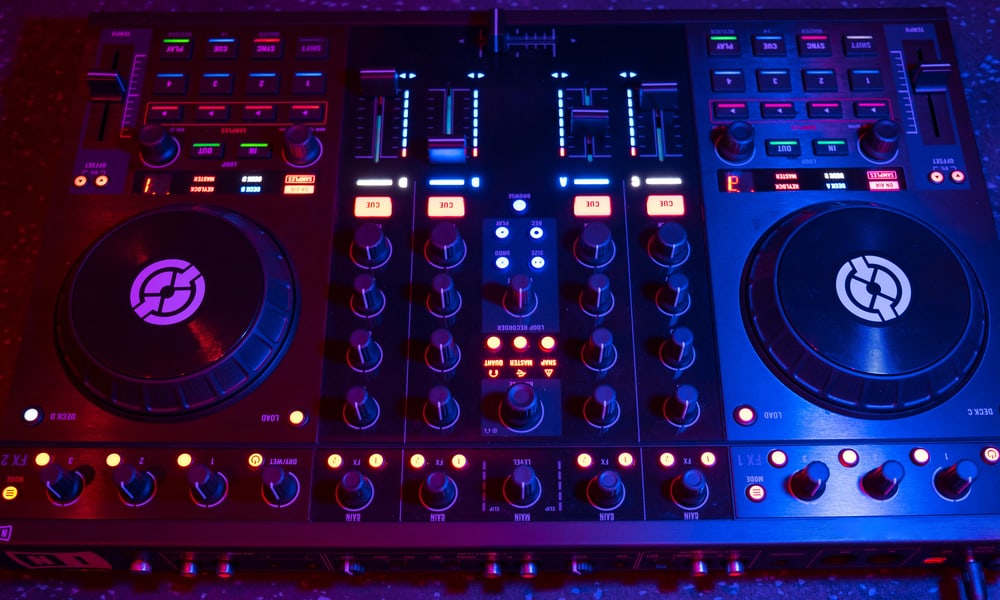
For the novice DJ who wants inexpensive equipment to learn the basics, DJ controllers offer the best of all worlds.
If you don't know what a controller is, you can basically think of it as a hybrid of DJing on a laptop and DJing with players and a mixer.
The controller is connected to your laptop and everything runs through your DJ software, but instead of controlling the knobs and buttons on the screen via the mouse and keyboard, you have a physical interface in front of you to touch.
So, for example, if you want to move the crossfader across on the screen, instead of doing it with the mouse, you do it with the physical crossfader on your controller.
Some DJ software – like Mixx – shows a mixer on your laptop screen, and if you use Mixx with a controller, you will see the crossfader slide across on the screen when you move the physical crossfader.
However, since the controller feels almost the same as using a "real" mixer, with many types of DJ software, you don't even have a mixer on the screen. This is the case with Pioneer's Rekordbox software and compatible controllers, for example.
In my opinion, controllers offer the best way into DJing because of the level of functionality they offer compared to how much they cost.
For a beginner, Pioneer's Rekordbox-compatible DDJ-400 or the Serato-compatible equivalent, the DDJ-SB3, are solid options. They allow you to master the basics of mixing and get a feel for DJing without having to invest too much money.
Other brands like Denon, Numark, and Reloop also make solid entry-level controllers that could be worth checking out.
However, when you start to play gigs, you will need to upgrade to something a bit better.
The Pioneer DDJ-1000 flagship controller costs a lot more than entry-level controllers but gives you much of the same functionality as a full player-plus-mixer setup that you will find in a club.
You could easily take this controller to play at gigs, but you will be able to transition easily to Pioneer CDJs if you get booked to play somewhere that has its own gear already.
e). All-in-one systems
All-in-one DJ systems have also become more popular in the last few years. They are basically a player-plus-mixer setup that comes as a single unit.
These can be more expensive than controllers but also offer a relatively affordable way to get your hands on some basic kit.
With these, you don't need a laptop. You just bring your music on your USB, plug it in and you're good to go.
One big plus is that you don't have to look at a laptop screen while you're playing, so you can concentrate more on your crowd.
They are also portable, making them a good choice for mobile DJs who need to carry their own equipment to gigs.
f). Headphones

One of the other essentials any DJ needs to own is a solid pair of headphones. At the beginning, you don't need to spend a fortune on them, but if you're going to be using them for gigs, you'll need ones that can block out the external noise.
For this reason, a pair of specialist DJ headphones from the budget end of the price range is a good place to start.
Note that Bluetooth headphones are useless for DJing. With Bluetooth, there will always be a lag between the signal being sent and the sound being played – this is called the latency.
For DJing, the sound you hear has to be perfectly in sync with the music coming out of the speakers, and any latency will make it impossible to play.
g). Speakers, amplifiers and monitors
At the beginning, you just need something that will play music and let you practice at home – and for this, you can normally run your DJ setup through your regular stereo.
However, for better sound quality – and for anyone who needs to supply all the equipment for gigs like weddings – you will need to look at amplifiers and speakers.
When playing out, you also need a monitor speaker. This is a speaker that faces you while you're playing so you can hear the music clearly.
If you try to DJ from the sound of the speakers facing the crowd alone, there will be a lag, and you may also experience an echo effect as the sound bounces off the walls and comes back to you.
All of this will make it much harder for you to hear what's going on, making a monitor essential in most environments.
However, speakers, amps, and monitors are equipment you can think about purchasing later if you need them for gigs. You might not need any of this when you're first starting out as a bedroom DJ if you can play music through the equipment you already own.
Step 4. Build your record collection
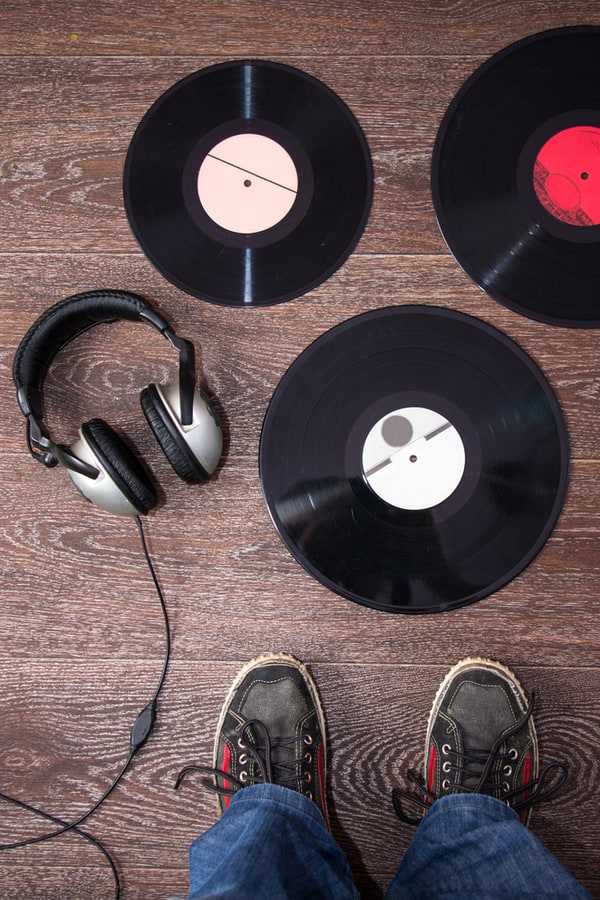
Whichever setup you decide to go for, the next step is to start building your record collection – and that means, if you're serious about being a DJ, you're going to need to spend a lot of time listening to music.
The type of music you amass depends on the kind of DJ you want to become. If your dream is to become a wedding DJ who can keep a dancefloor of drunk grannies going all night, you'll have to set about acquiring all the classics.
You'll also need to keep an eye on the charts so you have all the latest pop songs ready for your next gig.
However, if you want to become a more specialist kind of DJ, playing house, or techno, for example, this part will require a bit more dedication.
Put it like this, what is the main part of a DJ's job?
You might imagine it's the performance, the two hours they spend behind the decks under the lights of the club, but in fact, a major part of what a DJ does is the work they put in between gigs.
Any part-time hobbyist can download the top ten from Beatport each week, but if you want to stand out from the competition, you need to have your own style, and that means you need to find records that other people don't have.
A big part of your job as a DJ is spending time uncovering music that other people don't know. Non-DJs don't have the time to go trawling through the latest releases each week. But when they go to a club, that's what they want to hear.
So as a DJ, your job is to listen to lots of music – and pick out the best tracks to fit into your set.
Step 5. Learn the basics
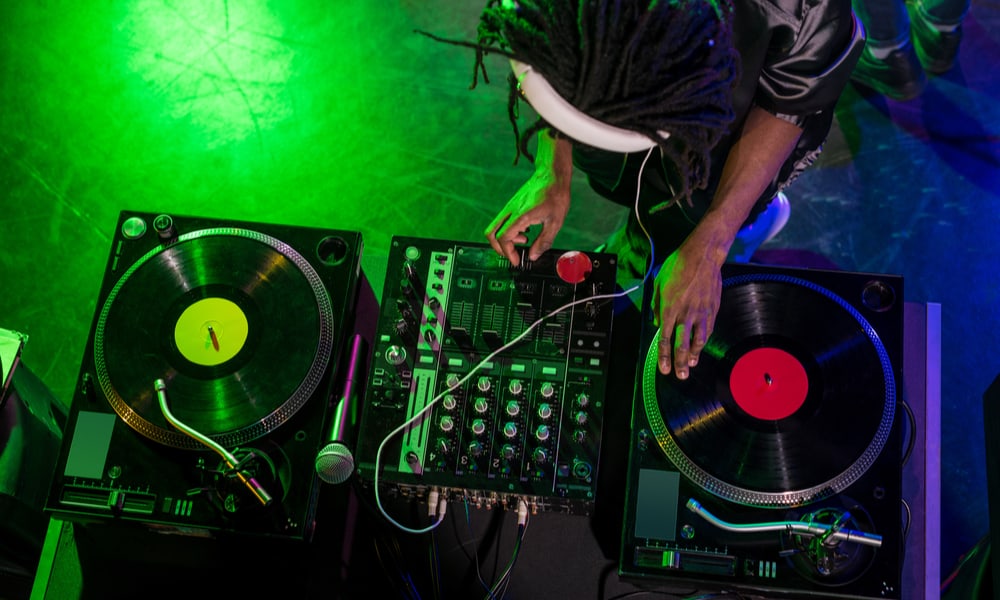
So you've got your music equipment and you've got a few tunes in your record box, so can you go out and play in front of people straight away?
Not even close!
If you try to play in front of people before you know what you're doing, you'll make a fool of yourself and you'll be booed off the decks.
Before you're ready to play in front of people, you need to learn the art of DJing, so now it's time to put in the hours of practice.
Beatmatching
In the old days, with turntables and vinyl, the first skill you had to master before you could even consider playing out was beatmatching.
Different tracks have different tempos, and if you want to mix music and transition smoothly from one track to another without creating a jarring and inharmonious racket, you need to learn to get the records playing at the same speed.
To do it the old-fashioned way, you listen to the music that's coming out of the sound system with one ear while listening to the next track through your headphones with the other.
You then move the tempo control on the deck until the tracks are in time and playing at the same speed.
The theory is, once the beats are matched and the tempo is the same, you can then use the crossfader to fade one track in and the other out seamlessly, allowing your crowd to keep dancing.
Beatmatching digitally
Back when there was only vinyl, what I've just described is what all DJs had to do.
You can still do it the old way if you like, but now most equipment includes a readout of the tempo, so with digital music, you can do it visually instead.
But you nowadays, you don't even need to do this, because most gear has a sync button that does it for you.
On software like Rekordbox, there's also a quantize feature that ensures the beats of the two tracks you are playing are perfectly lined up, so nowadays, it's perfectly possible to DJ without being able to beat match manually at all.
There's a big debate over whether DJs should use the sync button, with many people claiming that if you don't beat match manually without using sync, you're not a real DJ.
Other than saying there's a whole lot more to DJing that just beatmatching – and that anyone who thinks beatmatching is a DJ's main or only skill doesn't understand the art – I'm not going to go into the debate here.
However, learning to get two records playing in time on their equipment and then transitioning seamlessly from one to the other is the first thing a DJ needs to learn how to do.
Work on your transitions
Once you've mastered the basics of beatmatching and fading from one track to another, you need to work on improving your transitions. There are loads of techniques you can learn, and the ones you use will depend on what kind of DJ you are and the kind of music you play.
The best thing to do is to go onto YouTube and watch tutorials about DJing for more tips and tricks. You can learn to mix with the EQs, you can do stuff with the effects on your mixer, and there are plenty of other ways to be creative about transitioning from one track to the next.
Here's a good example of the kind of video you can watch.
Keep working at it every day, and eventually, you will be good enough to show off your skills in public.
Learn your music
Another part of learning the craft of DJing is becoming extremely familiar with the music you want to play.
You need to learn the tracks you have in your record box; you need to know the intros and outros, you need to know when the breakdown starts or where the drop comes and you need to know when the vocals come in.
It is only by really knowing the music you play that you will be completely in control of your mixes – otherwise, you are just cueing a track, fading it in and hoping for the best. Sometimes this might work, but sometimes it will end badly for you.
Learn how to build a set and read a crowd
DJing is not only about transitioning from one track to the next, though. You also need to know how to build a set. You need a start, a middle and an end. You need to learn how to tell a story with your music.
You also need to learn how to read a crowd, although this part will only come when you start playing in front of people.
This is perhaps the hardest part of being a DJ. Anyone can buy DJ gear, music is available for everyone to buy and it's not that hard to learn how to do a basic transition from one track to the next.
What's more difficult is learning how to take the dancefloor on a journey, knowing how to construct your set, and understanding what to play next to take the crowd where you want to go.
You also need to be able to react, speeding things up at the right time or slowing it down when necessary. Mastering this part will take time, but being in control of your set rather than just playing random tracks is what marks out a competent pro from a rank beginner.
Step 6. Look for gigs
Now it's time to look for somewhere to play. Maybe you got into DJing because you knew you wanted to make a career out of it, or perhaps you bought your entry-level equipment for a bit of fun and it developed from there.
However, eventually, there will come a time when being a bedroom DJ is no longer enough, and you want to get out there and start showcasing your skills.
It's like someone who buys a guitar and starts having lessons. At first, you need to learn to play chords and simple songs, but eventually, there comes a moment when you want to play in front of people.
So how can you find somewhere to play?
Play at house parties
A good way to get your feet wet is to play at house parties for friends. If someone is having people over and you have your own DJ equipment, you can offer to bring it with you and take care of the music for the night.
You probably won't get paid – you're doing it for the love of the music and to get some experience under your belt, but it will give you your first taste of what it's like to be in control of a dancefloor as you show off everything you're capable of.
Play for free

You might find the best way of getting your foot in the door is to offer to play somewhere for free. Some people might not like doing this, but it can be a great way of graduating from playing in your bedroom or at friends' parties to actually playing in public.
Perhaps you know a bar in your local area where you can spin a few chilled tunes on a Saturday afternoon or a club that will let you warm up before most people arrive.
If you can find places like this where you have a chance of playing, offer your services for free.
Remember, a bad DJ can empty a bar or club, costing the owner a fortune in takings, so they're not going to take a risk on an unproven DJ at peak times.
However, by playing for free and building your experience, you will be a far more attractive prospect for owners looking for someone they can rely on, and this will also give you a way to put your name known out there.
Just don't play for free forever – if it's working out, make sure you ask for them to start paying you after the first couple of weeks!
Record your mixes
In the old days, it used to be called "making a mixtape", but nowadays, most people haven't even seen a cassette for decades.
The principle is the same, though. If you want someone to book you to play, you need to show them what you can do, and recording your mixes at home is the best way of doing it.
You can record your mixes onto USB sticks and hand them out to anyone you think seems interested – although bear in mind, just walking into every bar, handing over a USB and walking out will probably not help much. The chances are, they'll never listen to it.
But if you go into a place and talk to an owner who seems interested, handing over a copy of one of your mixes is a good way of selling yourself – as long as it's up to standard!
You can also upload mixes to places like Soundcloud or YouTube, so if you meet someone who seems interested but you don't have anything to give them, at least you can tell them where to look to find an example of what you do.
Ask around
Keep asking around and talking to anyone who might represent a way into the scene. With DJing, as with many similar jobs, if you've got the talent, it can be all about getting your first break.
Once you've started playing somewhere, you'll have the experience to show people who might want to hire you, but before that happens, you always need to be on the lookout for opportunities.
Consider playing weddings and parties
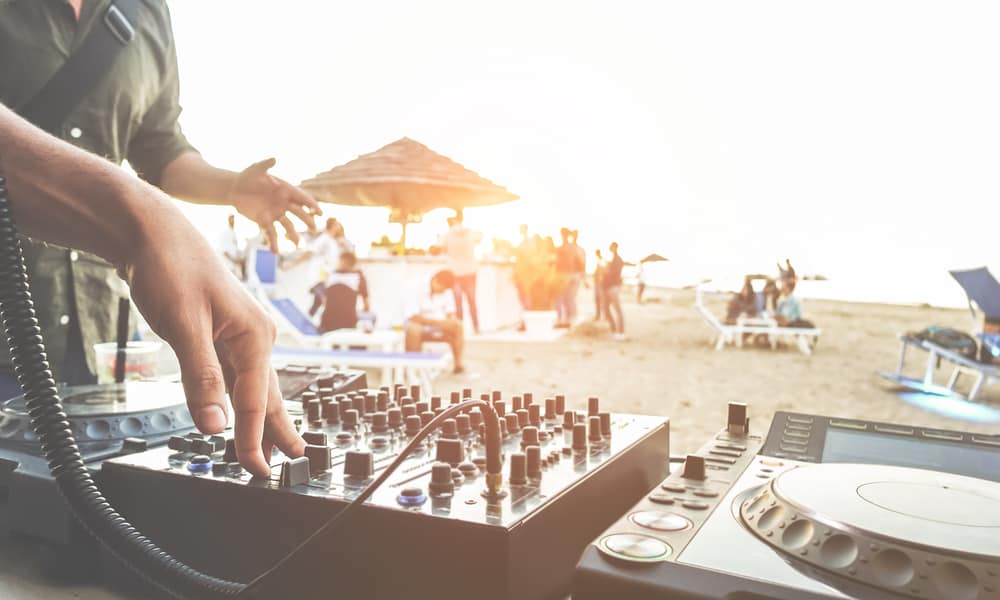
Depending on what you hope to achieve, playing at weddings and other functions may be something you are not willing to consider. However, if you are trying to make ends meet as a DJ, this can be a useful way of paying the bills while also getting more experience behind you.
You will probably have to play terrible music you despise as well as talking to the crowd and telling jokes into the microphone, and for some people, this can feel like selling your soul.
However, some people love it, and many make a career out of this kind of work, so it's really about what you want from DJing and the kind of DJ you want to be.
Step 7. Be original
Whether or not you are willing to do weddings and similar gigs at the beginning, let's assume this is not the dream DJing job you imagined. So how can you move on from there and start receiving bookings in the kinds of places you want to play?
Part of this is about developing your own individual style, and this is where the DJs at the top of the tree stand out from those further down the pecking order.
When a DJ like Carl Cox, Black Coffee, or Amelie Lens is playing, if that's the type of music you love, you can tell who's on the decks just from the music, even if you don't know it's them.
But how can that be? They're just playing other people's music, right? Well, they're probably playing some of their own tracks too, but the point is, they each have their own unique and unmistakable style – and if someone else sounds the same, it means they're trying to copy.
So how do they do this? There are a few ways.
First, it's about the music they choose to play. Sometimes, there are certain tracks we hear that make us think, "that sounds like the kind of thing Coxy would play". That's because Carl Cox – eclectic as he can be – has his own distinctive sound, and that's why people pay lots of money to hear him play.
Second, it's about their style of mixing. Some DJs like long and subtle transitions while others like to drop a track in suddenly. Some tend to add lots of effects while others can be very creative in chopping up different tracks together to create something new.
The point is, if you want to stand out, you need to sound different from other DJs, and this means you need to develop your own distinctive sound.
You'll be able to play in your local bar on a Saturday night by sounding the same as everyone else, but if you want to hit the big-time, you need to stand out.
Step 8. Build your profile
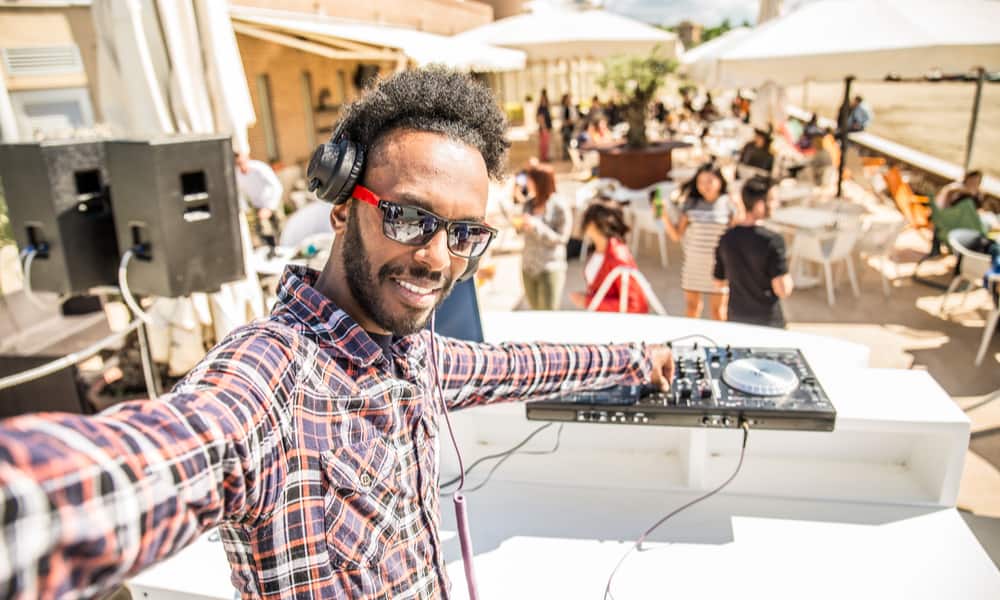
In a perfect world, your hard work, hours of practice, unique sound, and innate talent as a DJ would be enough to propel you to superstardom, but I'm afraid that's not quite the way it works.
You see, you may have dreams of headlining the big summer festivals, but unfortunately, so do countless other wannabe DJs, so you're also going to need to work hard at building your profile.
You'll need to be all over social media – you need Instagram, Facebook, Twitter, and everything else, and you need to build your following.
If you play gigs, put photos and videos up every time. Let people know where you've played and where you're playing next so you can start building your fan base.
Once you get hold of this, it can really snowball. The more people see you play, the more social media followers you will have. The more followers you have, the more people will want to see you. The more people want to see you, the more promoters will want to book you. And the bigger places you play, the more social media followers you will attract.
Some people have also made a name for themselves through YouTube channels, and the concept is the same. The more you are visible and the more followers you have, the more in-demand you will find yourself, and this will lead to bigger and better gigs.
Step 9. Try your hand at producing
One short-cut to the top is if you can become successful as a music producer.
DJing and music production are distinct but related fields, and many of the biggest names in the world of electronic music first made their names making music in the studio.
Think of the Martin Garixxes and the Avicii's of this world. They achieved international fame through the music they released rather than working their way up through playing small bars and clubs.
But then their fans want to see them at festivals, and since they're not singers or in a band, they DJ.
Those festival-headlining EDM sets might not be the kind of DJing you want to do – but if you're a talented producer, it can certainly open doors and accelerate your rise to the top in the world of DJing.
Step 10. Stick at it and work your way up
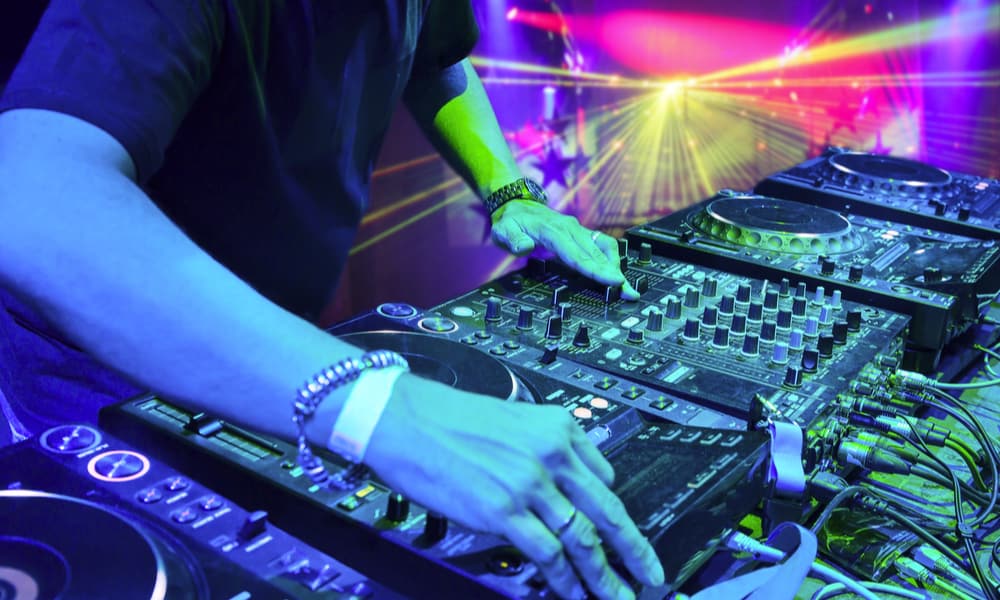
Being a DJ is not a golden ticket to superstardom, a jet-set lifestyle, and untold riches. It usually takes a long time to become established and successful – and even then, very few make it past the level of playing the local clubs in their area.
But stick with it. Work hard, practice, build your record collection, build your profile, and never give up. The only way you're going to make it is with determination and tenacity.
Sometimes you will need to have a thick skin, sometimes you will face rejection, and sometimes you will feel like quitting. However, if you want to be successful, you just have to keep going.
Once you move past your first gigs, you will be able to start working your way up. You might land yourself a residency in a local club, and then you might start getting booked for gigs further afield.
When this happens, you will know you're on the right track and that all your hard work is starting to pay off.
Do it for the love of the music
My final word of advice is that if you want to become a DJ, do it for the love of the music. Don't do it for fame, don't do it for the superstar lifestyle and don't do it for the money. Perhaps all of this will come later if you're good enough and if you get lucky, but if you start doing it because of your passion for sharing music with people, you will never be disappointed.
how to become a dj
Source: https://www.nonamehiding.com/how-to-become-a-dj/
Posted by: lewisgoicame.blogspot.com

0 Response to "how to become a dj"
Post a Comment